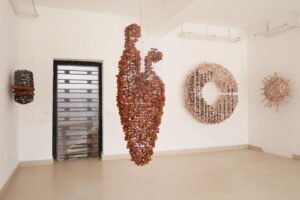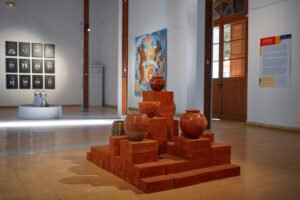One of the longest-running biennials on the African continent is Senegal’s Dak’Art, along with Mali’s Les Rencontres de Bamako for photography. Dak’Art was founded in 1989 to provide a forum for innovative methods of producing contemporary art in Africa.
The First World Festival of Black Arts, which was held in Senegal’s capital city of Dakar in April 1966 and was founded by the nation’s first president, Léopold Sédar Senghor, served as the event’s inspiration. Senghor, a cultural theorist, poet, and politician, had contributed significantly to the development of the anti-colonial, Black consciousness-raising Négritude movement in the 1930s.
Three decades later, he was assisting in setting up the framework in Senegal for the elite national art scene to flourish.
To revive artistic production, the Dakar-based collective Laboratoire Agit’Art (founded by the artists Issa Samb, Djibril Diop Mambéty, and Youssouopha Dione) started to challenge Négritude in the 1970s through a variety of performances and workshops that offered critiques of the dominant philosophies.

The cultural legacies of Négritude, the First World Festival, and Laboratoire Agit’Art all contribute to the description of the progression of Senegalese society from colonial times to modernism and post-colonial times, and they continue to have an influence on the nation’s contemporary art scene.
During a study trip to West Africa in 2019, I initially went to Dakar. It seemed at the time that non-governmental groups like Village des Arts, Maison Assa Dione, RAW Material Company, Espace Medina, Laboratoire Agit’Art, and Atelier Céramiques Almadies were leading most fascinating new artistic endeavors.
When I returned to Senegal this year to attend Dak’Art 2022 (the biennial’s 14th edition, which was postponed for two years due to the COVID-19 outbreak), I was astounded by the amount and caliber of visual arts work that it represented.
Les Manufactures Sénégalaises des Arts Décoratifs in Thiès, a city some 35 miles west of the capital, as well as in Dakar (at locations like the Institut Fondamental d’Afrique Noir (IFAN) and Maison de la Culture Douta Seck), was also where the evidence was found.
The Dak’Art theme for 2022, “Ndaffa / Forger / Out of the fire,” alludes to many creative potential and transformational actions. Dr. El Hadji Malick Ndiaye, the artistic director of the biennial, bases his argument on the devotion to creative potential and the development of fresh imaginaries.
The word “Ndaffa,” which means “to forge” in the Serer language (spoken in Senegal and the Gambia) and refers to the act of creating, recreating, and kneading, was used by him to name the event. This designates it as an occasion that encourages artists to reconsider thinking in terms of their native tongues rather than the languages that colonialism introduced to Senegal. The Palais de Justice in Dakar is the site of the biennial’s major exhibition, which includes pieces by 59 artists from more than 50 different African nations and the African diaspora.
Highlights include an installation by the art collective Troubled Archive that questions the creation of colonial clichés using photos and archives from European museums, as well as Florine Démosthène’s ethereal collage self-portraits that examine topics of race and gender. Abdoulaye Konaté, a Malian artist who won the biennale’s Grand Prize in 1996, also has current and brand-new large-scale textile pieces on display in this main exhibition.
These works are part of a contemplative display of abstract woven tableaus that address geopolitical topics with impact well beyond the local level. The exhibition “Black Rock 40,” which features work by former residents of the artist-in-residence program of the same name established by American artist Kehinde Wiley in 2019, also features works by Collectif Ban, a group of four young Senegalese ceramicists who opened a

New ceramics space in Dakar, Ban Workshop, in 2020, intending to preserve and reinterpret centuries-old ancestral ceramic practices.
The biennial’s extensive satellite event program, LE OFF, which is now in its 20th year and includes activities at over 400 locations, goes beyond Dakar to include the Petit Côte area of Senegal and the northern city of St. Louis. LE OFF’s most impressive display was at Selebe Yoon: “Now/Naaw,” a retrospective of artist El Hadji Sy’s work whose title contains a Wolof word that translates to “to fly” (a language spoken in Senegal, Mauritania, and the Gambia).
Sy’s painted kites cover the gallery’s interconnected spaces and stairwell. The founder of Dakar’s Galerie Atiss, Aissa Dione, organized another impressive exhibition that took place over two locations.
It featured the work of 15 local and international artists, including Elolo Bosoka, a young Ghanaian artist who created monumental sculptures from trashed sacks; painter Ngimbi (Luve) Bakambana, whose vibrant paintings reflect on the body and interior scenes; and Serigne Mbaye Camara, whose large-scale Together, Dak’Art and LE OFF provide a striking example of what the sharing environment that defines Dakar’s contemporary art scene is capable of producing.
When discussing how crucial the biennial’s program was for highlighting new voices, Marie Hélène Pereira, director of programs at RAW Material Company, said: “…independent art initiatives and institutions continue to shake the ground with thoughtful proposals for exhibitions and live events that took place all over the city.” Young creative brains in Senegal hold the key to the country’s future in the arts.


















